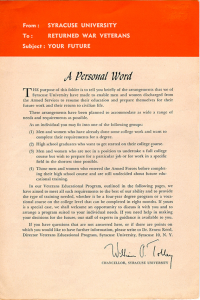In the aftermath of World War II, Chancellor William Pearson Tolley emerged as a key figure in reshaping the landscape of higher education for returning veterans. His visionary leadership and commitment to providing educational opportunities led to the establishment of Syracuse University as a place of hope and learning for those who had served our country.
Pioneering for Veterans’ Education
Graduating from Syracuse University’s Students Army Training Corps (SATC) himself, Chancellor Tolley understood the pivotal role higher education could play in veterans’ lives. In 1944, He introduced Syracuse’s “uniform admissions program,” ensuring that all military personnel received admission to the university upon their return from the war. Tolley’s foresight recognized the urgency for immediate educational opportunities for veterans, capturing the spirit of the post-war era.

Recognizing the diverse needs of returning veterans in their transition to civilian life, Chancellor Tolley spearheaded the Veterans Educational Program. This initiative aimed to accommodate a wide range of educational requirements, focusing on tailoring programs to meet individual needs. In a personal message to veterans, Tolley emphasized the university’s dedication to helping individuals customize their educational paths to specific needs and aspirations.
Chancellor Tolley’s advocacy extended beyond the confines of Syracuse University. He played a crucial role in championing the rights of veterans through the Servicemen’s Readjustment Act of 1944, commonly known as the GI Bill. This landmark legislation provided unprecedented benefits, offering one free year of higher education for every ninety days of service. Tolley’s efforts were instrumental in securing these rights, opening the doors of education for countless veterans.
The impact of the GI Bill was transformative, and Syracuse University experienced an unparalleled surge in enrollment. By 1947, the student body had tripled in size, with approximately 9,000 student veterans among the total enrollment of 18,000. The total cost of the World War II education program amounted to 14.5 billion, underscoring the nation’s commitment to investing in the future of its veterans. The number of U.S. citizens graduating from college skyrocketed from about 160,000 in the late 1930s to 500,000 by 1950.
To accommodate the influx of students, Syracuse University underwent significant changes. Classrooms sprouted up around the main campus, and prefabricated metal structures, remnants of a California military base, were repurposed as classrooms. The unique Quonseteria, a temporary dining hall, became a symbol of the university’s adaptability during this transformative period.
Chancellor Tolley’s Legacy
Chancellor William Pearson Tolley’s legacy extends far beyond his role in shaping post-war education. During his 27-year tenure, he transformed Syracuse University into one of the nation’s largest private universities. Tolley’s dedication to education was unwavering, and his refusal to succumb to pressures during the Vietnam War showcased his commitment to the principles he believed in.
Chancellor Tolley’s indelible mark on higher education and veterans’ rights endures. His visionary leadership, instrumental role in the creation of the GI Bill, and commitment to inclusivity have left an everlasting legacy at Syracuse University and beyond. As we reflect on the post-World War II era, Chancellor Tolley stands as a symbol of the transformative power of education in shaping a better future for all.
In forthcoming articles, we’ll delve deeper into pivotal moments from SU’s timeline, unraveling the interconnected web of history that defines the University’s enduring legacy in supporting veterans and military students. Stay tuned for more insights into SU’s remarkable journey.

